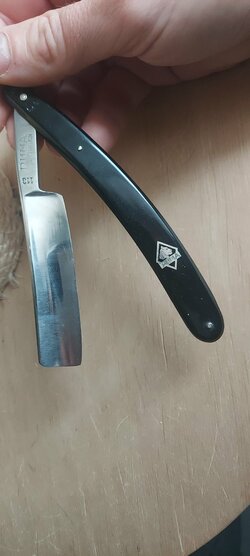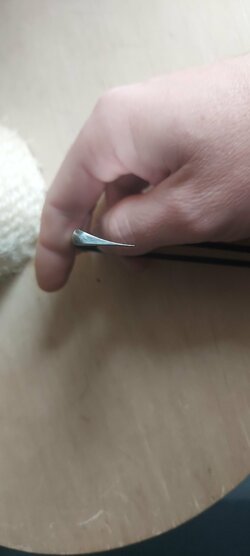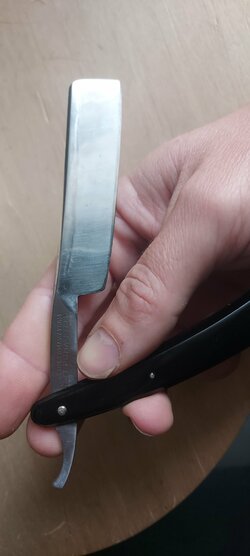I have a wet shaving friend in Italy who has an unusual Puma and wants information on it. Has anyone information on what appears to be a Japanese one- sided style Puma for the Japanese market? It looks like a standard Puma in all respects but the grind. Many thanks.
You are using an out of date browser. It may not display this or other websites correctly.
You should upgrade or use an alternative browser.
You should upgrade or use an alternative browser.
Unusual Japanese blade grind style Puma, any thoughts?
- Thread starter Fillifan
- Start date
Most probably a microtome

 www.badgerandblade.com
www.badgerandblade.com

Microtome or straight razor.I am not sure.
Ok, here is the story. I just purchased a Joseph Rodgers and Sons Cutlers to their Majesties Razor (of some sort). Upon inspection, I noticed "School biological lab # 4" inscribed on one scale. My buddy informed me I had mistakenly purchased a Microtome...but I am not convinced. The blade...
 www.badgerandblade.com
www.badgerandblade.com
- Thread starter
- #3
Thanks, I will pass that idea on to my friend.
Yea…
That’s not a factory grind.
That’s not a factory grind.
Antique Hoosier
“Aircooled”
I excitedly purchased one of these years ago from a knife dealer in Georgia NOS. Thankfully I think I paid maybe 50 bucks.
It’ll be great if he slices samples to examine under a microscope in his home lab after it’s honed up.
- Thread starter
- #7
Thanks to all who responded
A microtome blade will be flat on one side and beveled on the other. It's held in a clamp and either the sample is driven over it or the blade is swung across the sample (which will be embedding in either wax or nitrocellulose as a rule). Very very thin slices.
I never had much luck sharpening the knives we used (which were actually very heavy blades with a normal double sided bevel) and we used utility knife blades instead. Harder to set up, but much sharper and less hassle. The sharpening tool was a rotating glass disk used with abrasive powder and water, bare glass to finish. Not terribly sharp.
The flat side will make it very difficult to shave with, and equally difficult to actually hone on both sides.
I never had much luck sharpening the knives we used (which were actually very heavy blades with a normal double sided bevel) and we used utility knife blades instead. Harder to set up, but much sharper and less hassle. The sharpening tool was a rotating glass disk used with abrasive powder and water, bare glass to finish. Not terribly sharp.
The flat side will make it very difficult to shave with, and equally difficult to actually hone on both sides.
Yea…
That’s not a factory grind.
Why wouldn't a Puma microtome
have a factory grind?
“Why wouldn't a Puma microtome
have a factory grind?”
It probably would, but that grind is not a factory grind. Looks like some one ground it on a sheet of sandpaper or on the sidewalk.
have a factory grind?”
It probably would, but that grind is not a factory grind. Looks like some one ground it on a sheet of sandpaper or on the sidewalk.
Or tried to sharpen it on too coarse a hone/sandpaper without knowing how to sharpen a microtome blade.“Why wouldn't a Puma microtome
have a factory grind?”
It probably would, but that grind is not a factory grind. Looks like some one ground it on a sheet of sandpaper or on the sidewalk.
I think the grind is factory.
Someone needs to find an old Puma catalogue, see if the 113 model is mentioned.
Last edited:
Probably has a slight hollow on the "flat" side just like a single bevel Japanese knife. Very hard to keep the back completely flat otherwise.
It would be unusual to use one free-hand, a microtome is a machine that move the blade (or the specimen) across the edge, then advances the specimen a very small amount (a few thousandths of an inch usually) and then cuts another very thin slice.
The slices are then adhered to glass microscope slides and stained for examination.
It would be unusual to use one free-hand, a microtome is a machine that move the blade (or the specimen) across the edge, then advances the specimen a very small amount (a few thousandths of an inch usually) and then cuts another very thin slice.
The slices are then adhered to glass microscope slides and stained for examination.
That is a mechanical microtome, or section cutter. But many razor makers also made single concave sided, straight razor like blades for doing the same thing manually. The technical term for which is a plano knife, I believe.It would be unusual to use one free-hand, a microtome is a machine that move the blade (or the specimen) across the edge, then advances the specimen a very small amount (a few thousandths of an inch usually) and then cuts another very thin slice.

Search results for query: microtome
 www.badgerandblade.com
www.badgerandblade.com
Edit: Surprisingly, it seems they are still made, and can be bought new..
Last edited:
- Thread starter
- #14
I have passed all of this on to my pal.
Probably has a slight hollow on the "flat" side just like a single bevel Japanese knife. Very hard to keep the back completely flat otherwise.
It would be unusual to use one free-hand, a microtome is a machine that move the blade (or the specimen) across the edge, then advances the specimen a very small amount (a few thousandths of an inch usually) and then cuts another very thin slice.
The slices are then adhered to glass microscope slides and stained for examination.
They can be pretty flat.
And there's a difference between what a microtome is now,
and what a microtome used to be.
Last edited:
Similar threads
- Replies
- 4
- Views
- 540
- Replies
- 2
- Views
- 772
- Replies
- 15
- Views
- 2K
- Replies
- 28
- Views
- 2K
- Replies
- 2
- Views
- 688





